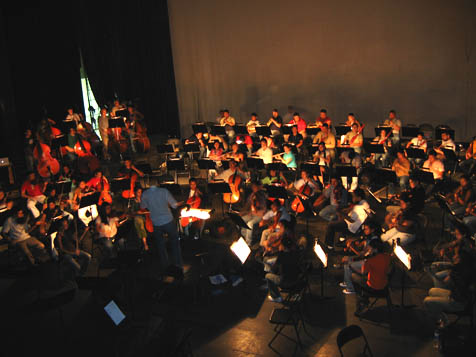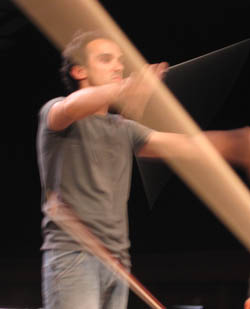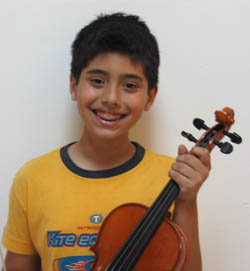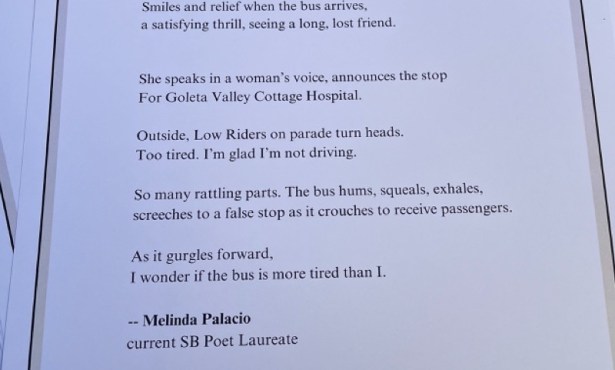The Power of Music
The National Youth Orchestra of El Salvador

On a hot, lazy afternoon, teenagers sit smoking cigarettes in a fancy cafe, nibbling cakes and chatting about fashion. A few blocks away, children throw jacks and ride bicycles along a filthy cobblestone alley infested with cockroaches and raw sewage. This is daily life in San Salvador, the capital of El Salvador, and home to these disparate worlds of luxury and desperation. With a recent civil war and increasing gang violence, the country seems to have little hope for a sustained peace. But in the midst of extreme poverty, rising crime rates, and distrust between social classes, a group of young musicians dares to bridge the gap between rich and poor. This is the National Youth Orchestra of El Salvador.
During the past 22 months, I have worked as a Peace Corps volunteer with the youth orchestra, a group of 70 students whose ages, educational opportunities, and economic backgrounds are as varied as the instruments they play. Some of their parents employ multiple servants; other students struggle to find a quarter for the bus. Every week, the children gather for classes and rehearsals. During a nine-month season, they present five full-orchestra concerts and a few chamber music performances.

The orchestra’s conductor and musical director is Mart-n Jorge, a 31-year-old Uruguayan who came to El Salvador for the position three years ago. A remarkably talented musician, he guides the students with discipline, constructive criticism, and fatherly affection. His face changes constantly as he conducts. No emotion goes unexpressed: anger, surprise, joy, expectation, ecstasy, pride. Occasionally, I notice the students mirroring his expressions on their own faces as they watch him.
Weekly rehearsals take place in the basement of the National Art Center, a dirty, barren hall with a bad echo. But during concert weeks, the orchestra rehearses in the 1,200-seat Teatro Presidente. I look forward to those weeks, when I sit alone in the dark, cool, empty seats, listening to the cacophony of rehearsal: the deep resonance of the cellos, the intricate unity of the violins, and the general chatter and chaos that take over during breaks. It reminds me of my own years in the Santa Barbara Youth Symphony.
When I was three, I sat in front of my parents’ huge, old-fashioned stereo speakers, mesmerized by the sounds of Mozart’s opera The Magic Flute. Growing up, I spent hours practicing the piano and the flute, and began teaching music lessons in high school. During my sophomore year of college at Stanford, I was a member of the pit orchestra for The Magic Flute, an experience that enhanced my appreciation of the opera’s message: the power of music to lead the way through life’s obstacles.
On my Peace Corps application, I mentioned that I hoped to make music a focus of my service, and when the National Youth Orchestra of El Salvador was offered as my official site placement, I readily agreed. The orchestra here is well established: We have a small office a few blocks from the rehearsal hall, a full administrative staff, a small collection of instruments, financial support from the government, and a board of directors that includes a former vice minister of the economy. With this framework in place, I have been able to focus all my attention on teaching music. Mart-n and I have developed an academy that includes instruments, music theory, and music appreciation classes. We have 60 beginning students who will advance into the orchestra in a few years.
As a teacher, I can explain aspects of music theory, but 21-year-old Emma has shown me what true passion means. “For me, music is something incredible,” she said. “When I am playing, I forget all my problems.” The orchestra’s only female brass player, she laughs sheepishly when she mixes up flats and sharps, and her eyebrows often wrinkle together as she takes diligent notes. She is studying medicine, but is also determined to become a great trombonist.
Twenty-one-year-old David lives in the vicinity of Ahuachap¡n, a 90-minute bus ride from weekly rehearsals. A wealthy patron of the orchestra provides David with a scholarship of $50 each month, which allows him to stay overnight in San Salvador three days a week and pay for his bus fare and meals. Nothing can stop David from making music-he is moving and humming constantly; rhythms and sounds dance in his veins. He once made up an entire song out of my name, twisting the syllables into beats and accompanying it with foot stomps. When I asked why he’s so happy, he seemed bewildered: “Well, why would I be sad?” But occasionally, I catch him gazing down at the floor, and wonder what sadness he is keeping inside.

With a tiny frame, uncombed hair, and mouth full of braces, 12-year-old Efra-n is the orchestra’s unofficial mascot. His intelligence is palpable, and his fascination with the English language often yields innovative responses to musical questions. Last year, we were studying the intervals of fourths and fifths, known in English as perfect intervals: P4 and P5. In Spanish, they are “justa,” 4J and 5J. When I asked Efra-n to remind everyone what the “J” stood for, he quickly racked his brain for an English word, and then blurted out, “Junior! Junior!” Efra-n eagerly embraces the concepts of hard work and advancement. In the recent auditions for the 2007 season, he moved up from 7th stand to 4th stand, second violin. He reported his promotion to me with pride and disbelief in his face. While so many children in this country cannot hope for much beyond their next meal, Efra-n wants to be the president of El Salvador.
The small moments are the greatest joy of my Peace Corps service: Azalea’s sheepish smile above the chin rest of her violin when she gets lost, the look of determination in Diana’s eyes as her fingers fly through a fast passage of Mozart, Fausto’s utter concentration as he flips between timpani, the tears that form in Mart-n’s eyes when 14-year-old Sandra plays Vivaldi’s “Winter” from The Four Seasons. As part of the 2006 season, the orchestra performed a modernized Magic Flute, complete with a drum set and acrobats. Sitting among the nearly 1,500 Salvadorans who came to the three nights of performances, I realized my musical education had come full circle: Kids whom I had helped in theory class were now performing the very opera that had inspired my life-long love of music.
When they play, these young musicians inhabit their own world-a world where they are all equal. In a sense, the orchestra is a kind of social experiment: Can these young people use music to bridge the gaps of education and opportunity so ingrained in their country? Can they transmit their new world to their audience? Research has shown that musical activities provide children with discipline, concentration, and focus. Participation in the orchestra is also teaching these children that they matter, and that they are capable of achieving greatness. In a disjointed and chaotic nation, the children of the National Youth Orchestra of El Salvador are creating the foundation for a world of peace and harmony.
Anna Forgie is a Santa Barbara native currently finishing two years of service as a Peace Corps volunteer in El Salvador.



